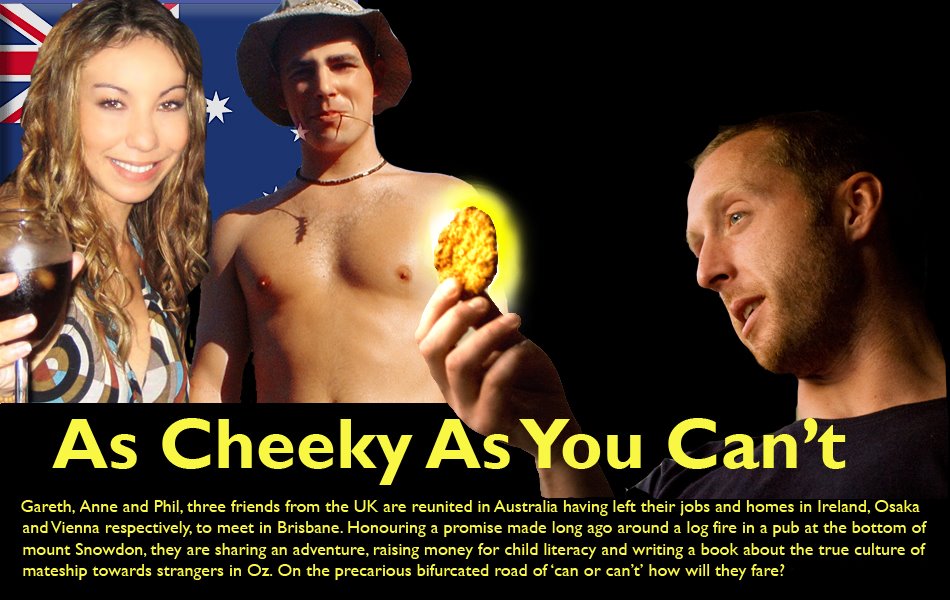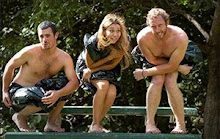The Top End, as it is known, was just a dirty great big empty space for the settlers, and they vied to make it habitable from early on. Traversing the coast from the eastern colonies they tried repeatedly to set up outposts there, and repeatedly abandoned them. From 1824 to 1849 they made numerous attempts to settle along the coast and as each attempt disastrously failed, they took this as a sign to learn nothing from their mistakes and try again, failing every time.
This despite the local Aboriginal population, the Larrakia or 'saltwater' people finding in the area an abundance of marine life, game, rockpools and natural springs. Of course, notwithstanding the fact that the monsoonal rains during the 'wet' and prolonged drought during the 'dry' complicate things a little, but they sought no lessons from the native people, trusting their own methods, and, as a result, it took some mammoth endeavours and another twenty years before anyone tried to settle there again.
With the route to the Top End blazed by John McDouall Stuart in 1862, they decided to try this time to go overland to settle, but still could not quite get the hang of it, and abandoned the post again. They must have been scratching their heads at this, yet no one thought to seek some wisdom from the people who occupied the lands, and lived there comfortably, namely the Larrakia Aboriginals.
So, it was in 1869 that they tried again. You can almost hear the pen scratching through the paper onto the thick oak desk as the Government man sanctions another trip to the Top End and it would not have been without some grave words that they were dispatched to settle up there, this time for good. To the east of the point where Stuart and his crew first sighted the Timor Sea from land, they established a new town, and named it Palmerston.
Not a lot happened in Palmerston. They were over 3000 miles from their bosses in South Australia and probably feeling the pinch over privations, with supplies taking weeks to arrive. Any farming they did usually ended in failure as knowledge of the climate slowly, and I mean slowly, dawned on them. Fishing proved a little more successful, as did the Pearling industry, bringing incomers from Thursday Island, Malaysia, Indonesia, and Japan into Palmerston.
In 1872 the Overhead Telegraph Line, that linked Adelaide with Darwin and, via an undersea cable to Java, with London and thus the rest of the world, was completed and connected. While still small and remote, the new town of Palmerston gained something of note with this strategic placement, and was to benefit further from this when two workers, while digging the holes for the posts for the Overhead Telegraph discovered gold.
The Pine Creek Gold Rush in the 1880s brought in people from all over. Writing as a journalist at the time the great AB 'Banjo' Paterson wrote that:
"Palmerston is unique among Australian towns, insomuch as it is filled with the boilings over of the great cauldron of Oriental humanity. Here comes the vagrant population of all Eastern races. Here are gathered together Canton coolies, Japanese pearl divers, Malays, Manilamen, Portuguese from adjacent Timor, Cingalese, Zanzibar negroes looking for billets as stokers, frail (but not fair) damsels from Kobe, all sorts of conditions of men" ('Paterson', 1898, p.23)
So this pick-'n-mix population settled, Palmerston reaped the benefits of the gold rush as more people flocked to the territory, and continued to do so until 1897. How do we know this so precisely? Because that was the year a cyclone tore through the fledgling community, flattening everything, scattering the inhabitants, destroying their homes and buildings. There had been a few before, somewhat nasty, but this one took the biscuit, and hurled it at two hundred miles an hour into the sea. It gets pretty lively up Top End.
Maybe that is why in 1911 South Australia ceded control of the Northern Territory, allowing them to go it alone, and become part of the Commonwealth. Duly done, they promptly changed the name of Palmerston to that which most thought it was called anyway, and Darwin was born, and the town-formerly-known-as-Palmerston got on with it.
Darwin went about its business, encouraging more people, improving the town, expanding its boundaries, dealing with the Aborigines in typically robust style through placing them in camps, under curfew, prohibited moving freely. That aside, life was good for the Darwinians. As capital of the newly independent Northern Territory it received funding and grand buildings were erected to commemorate this honour.
An eminent architect called John George Knight came up from Adelaide and set to designing some of Darwin's most impressive buildings. He also had a novel, bright and quite liberated view on how to deal with life in the tropics, and one which had more in common with the locals, the Larrakia 'saltwater people', than maybe he realised, when he said that 'the great secret of maintaining health in a hot climate is to expose the naked body so much as possible to the direct rays of the sun'.
Darwin was burgeoning and it appeared as if even the white Europeans were adapting to life there, abandoning starched collars and greatcoats for some au naturel let-it-all-hang-out. It was too good to last though. So in 1942 the Japanese squadron that bomber Pearl Harbour let loose over Darwin and did to the Aussies what they did to the Americans. Darwin was flattened once more, the residents scattered, leaving en masse for the southern states in the months of worry leading up to the attack, or killed in the air raid itself, or left destitute and homeless. The damage was great, and the rebuild took its toll on those left behind.
But, the silver lining the Aussies are great at finding, was that occupation by the forces had improved much of the before non-existent infrastructure that had hindered Darwin's growth. The Army left behind a new improved wharf, had sealed the dirt road that was the Stuart Highway from Alice Springs and built and established the water and power sources. So Darwin flourished. In the ten years from the end of the war Darwin's population nearly doubled to 60,000, more coming, as the rebuild appealed not only to peoples sense of civic pride but to their nation building pioneering spirit too.
Darwin was the capital of the Northern Territory and proud of it. How happily they lived, these new Darwinians, the settlers building the schools that educated their children, the pubs and clubs that they sung and danced and indulged in the by now firmly entrenched true-blue Aussie tradition of 'getting on it', and drinking beer.
As they prepared for Christmas in 1974, some were indeed 'getting on it', others were simply asleep, or wide-eyed and waiting for Santa, but Christmas did not come, and Santa, if he had tried at all would have been hurtled at 250 miles an hour to Timbuktu. Cyclone Tracy arrived in Darwin at midnight on Christmas eve and in one night destroyed Darwin again.
There was a warning, issued in the weeks and days coming up to the event, that a cyclone was forming, and some decided to leave, heading south (everywhere is south from Darwin, ask any Darwinian where they go for a holiday and they invariably say 'south', be it to western or eastern Australia), and those that remained were, according to the reports "pretty sloshed" come the time the cyclone arrived.
The wind screamed in just after midnight. The anemometer, designed to record wind speeds, was damaged and stopped recording after reading a gust of 217 mph when the storm was still building.
It was terrible. Families were airborne along with their homes, which just disintegrated. The roof came off, the rafters, the beams, then as the floorboards swirled violently they joined the fence posts, fridges and roof iron as projectiles.What they woke up to on Christmas morning was a scene of total devastation. 90% of Darwin was utterly destroyed. There were 49 deaths, with 16 missing at sea. The wind was so ferocious that it stripped the paint off the boats, many of whom broke anchor and were tossed like toys around the harbour. 12,000 homes were completely destroyed.
Darwin was flattened and reduced to rubble once more. There would have been people living in Darwin in 1974 who remember the 1942 bombings, and who may have thought to themselves what was going on. But, indomitable as these people are, they roled up their sleves and got on with it.
The population in Darwin is around 101,000 now. It has a breezy, light feel to it, with the tropical palms and giant tamarind trees secluding shade from the insistant sun. It gets a fair bit of rain, and the weather gets a wee bit lively from January through to March, but the unhurried and laid back lifestyle is what people come to Darwin for. There are no airs and graces, you can still go to most pubs and bars in flip-flops and t-shirt, and the smoking ban has yet to be enforced.
Maybe, just maybe, having been through what the Darwin people have been through, they have realised somewhere along the way, that life's too short, permanence is illusory, so they don't worry, and take things as they come. Despite its habit of falling down, Darwin is a pretty stand-up place.






















No comments:
Post a Comment